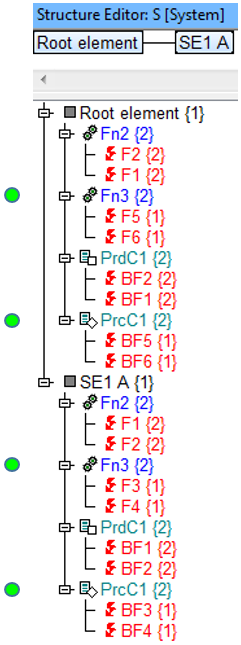Search:
Function- and characteristic types with inconsistent failures
Explanation:
A search will be performed for instances of function- and characteristic types which have inconsistent failures. The order of the failures is not important
Note:
- Types are IQ-objects that are recorded in Catalogs and carry information that is the same for all instances of the type
- Instances of IQ-objects are created when IQ-objects are selected from the Catalogs and reused elsewhere in the IQ-Software
Example:
Abbreviations
- ASIL = Automotive safety integrity level
- BF = Base failure of a base function
- BFn = Base function of a base structure element
- BSE = Base structure element
- Cl Prc = Classification for process characteristic
- Cl Prd = Classification for product characteristic
- Cl Req = Classification for requirement
- CM = Control method
- DA = Detection action
- DC = Diagnostic coverage
- DSCF = Dangerous safety critical failure
- Er Det = Error detection
- Er Resp = Error response
- F = Failure
- FIT = Failure in time
- Fn = Function
- FSM = Functional safety management
- IE = Inspection equipment
- LF = Latent fault
- LFM = Latent fault metric
- OC = Operating condition
- PA = Preventive action
- PE = Process element
- PFH = Probability of failure per Hour
- PMHF = Probabilistic metric for random hardware failures
- PrcC = Process characteristic
- PrdC = Product characteristic
- QM = Quality method
- QR = Quality rule
- Req = Requirement
- RMR = Risk Matrix Ranking
- RP = Reaction plan
- SE = Structure element
- SE ErDet = Structure element for error detections
- SE ErResp = Structure element for error responses
- SFF = Safe failure fraction
- SG = Safety Goal
- SIL = Safety integrity level
- SM = Organisational-SE for “safety mechanisms”
- SPF = Single point fault
- SPFM = Single point fault metric
- TF = Top failure of a top function
- TFn = Top function at root element
- TS = Test sample

- This structure consists of two structure elements, each of which have two functions (
 ), one
product characteristic (
), one
product characteristic ( ) and one process characteristic (
) and one process characteristic ( ). Each
function and characteristic has two instances {2}, which means they each exist twice in the structure. Each
instance of a function and characteristic has two failures.
). Each
function and characteristic has two instances {2}, which means they each exist twice in the structure. Each
instance of a function and characteristic has two failures.
- This Quality Rule identifies instances of functions and characteristics which have differing failures anchored at them. From the structure above, it is possible to see that the two instances of function Fn3 as well as the two instances of process characteristic PrcC1 have different failures.
- Function Fn2 and product characteristic PrdC1 do not have differing failures (note: the order of them in the list is not important for this QR).
Search result: ![]()
This example will deliver 4 hits: the two instances of Fn3 and both instances of PrcC1.